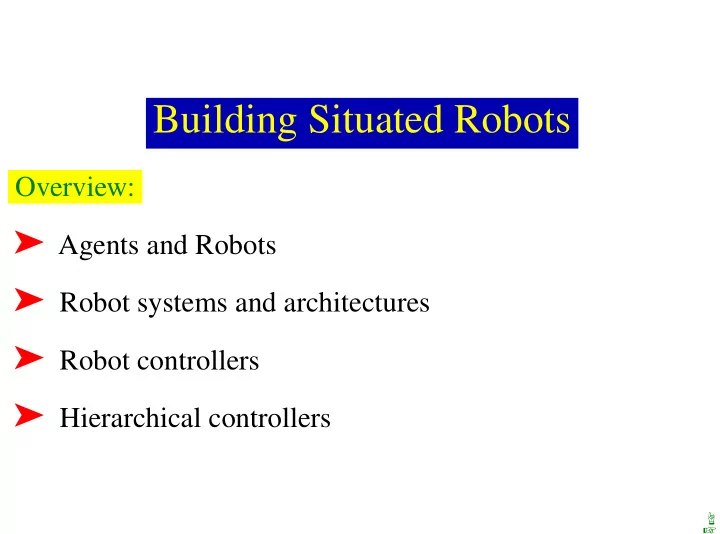

Building Situated Robots Overview: ➤ Agents and Robots ➤ Robot systems and architectures ➤ Robot controllers ➤ Hierarchical controllers ☞ ☞
Agents and Robots A situated agent perceives, reasons, and acts in time in an environment. ➤ An agent is something that acts in the world. ➤ A purposive agent prefers some states of the world to other states, and acts to try to achieve worlds they prefer. ➤ A robot is an artificial purposive agent. ☞ ☞ ☞
What makes an agent? ➤ Agents can have sensors and effectors to interact with the environment. ➤ Agents have (limited) memory and (limited) computational capabilities. ➤ Agents reason and act in time. ☞ ☞ ☞
Robotic Systems A robotic system is made up of a robot and an environment. ➤ A robot receives stimuli from the environment ➤ A robot carries out actions in the environment. ☞ ☞ ☞
A robotic system ROBOT CONTROLLER commands percepts BODY actions stimuli ENVIRONMENT ☞ ☞ ☞
Robot A robot is made up of a body and a controller . ➤ A robot interacts with the environment through its body. ➤ The body is made up of: ➣ sensors that interpret stimuli ➣ actuators that carry out actions ➤ The controller receives percepts from the body. ➤ The controller sends commands to the body. ➤ The body can also have reactions that are not controlled. ☞ ☞ ☞
A robotic system architecture ROBOT CONTROLLER commands percepts BODY actions stimuli ENVIRONMENT ☞ ☞ ☞
Implementing a controller ➤ A controller is the brains of the robot. ➤ Agents are situated in time, they receive sensory data in time, and do actions in time. ➤ The controller specifies the command at every time. ➤ The command at any time can depend on the current and previous percepts. ☞ ☞ ☞
The Agent Functions ➤ Let T be the set of time points. ➤ A percept trace is a function from T into P , where P is the set of all possible percepts. ➤ A command trace is a function from T into C , where C is the set of all commands. ➤ A transduction is a function from percept traces into command traces that’s causal: the action trace up to time t depends only on percepts up to t . ➤ A controller is an implementation of a transduction. ☞ ☞ ☞
States ➤ A transduction specifies a function from an agent’s history at time t into its action at time t . ➤ An agent doesn’t have access to its entire history. It only has access to what it has remembered. ➤ The internal state or belief state of an agent at time t encodes all of the agent’s history that it has access to. ➤ The belief state of an agent encapsulates the information about its past that it can use for current and future actions. ☞ ☞ ☞
Functions implemented in a controller For discrete time, a controller implements: ➤ a state transition function σ : S × P → S , where S is the set of belief states and P is the set of possible percepts. s t + 1 = σ( s t , p t ) means that s t + 1 is the belief state following belief state s t when p t is observed. ➤ A command function χ : S × P → C , where S is the set of belief states, P is the set of possible percepts, and C is the set of possible commands. c t = χ( s t , p t ) means that the controller issues command c t when the state is s t and p t is observed. ☞ ☞
Recommend
More recommend